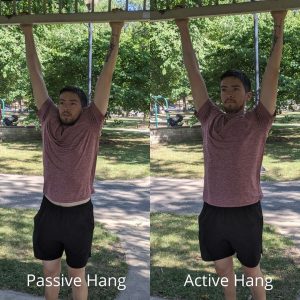Sep07Hanging For Shoulder Health: How Hanging Improves Shoulder Strength & Mobility
The shoulders have a knack for being one of the most notorious areas of the body that get injured. It’s because it’s a highly mobile joint that it often ends of being a spot of pain or discomfort. For those of you with cranky shoulders, what is often the hardest movement to perform? I’m willing to bet that it is the overhead motion. Going overhead requires a ton of shoulder mobility, and many of us don’t have that because of sedentary lifestyles that keep us hunched over everyday. Even for those of us that do have a great deal of ROM (range of motion), we still sometimes suffer from tight shoulders because of our constant hunchback posture. We’re always sitting in chairs, hunched over, or leaned over our phones, watching TV, etc.
And while there is no quick fix to your shoulder woes, there is one simple movement that you can do everyday to improve shoulder mobility, strength, and maybe decrease pain. That movement is something that you used to do as a kid on playgrounds, and that is called hanging.
Note: this is something that not everyone may be able to do right away, and if you have any serious shoulder pain or injuries then this may not be for you. If, however, you just suffer from stiff and tight shoulders, then this may help!
Hanging For Better Shoulders
The hang is a simple movement: you grab a bar or tree branch or some other sturdy surface, grip it tight, and hold yourself suspended in the air. If you can’t hold yourself up just yet, you can grab a lower surface to help support you. Simple enough, right?
There are multiple reasons why hanging is good for the shoulders. We’ll go into detail below.
1.) It Improves Mobility by Forcing You Overhead
Going overhead is often difficult for many people. So one way to work on it is to grab a pull-up bar and use your bodyweight as a stretching aid. As you hang, gravity does it’s thing and pulls your weight downward, thus forcing you into an overhead position.
2.) It Can Strengthen The Shoulders Passively
Even though hanging is a great stretch, it strengthens the shoulder in a sneaky way. By default, in order to hold yourself up without your socket dislocating, your muscles have to contract and keep everything in place.
3.) Improves Grip Strength
Holding your entire bodyweight over time gets tough. In order to hang on, your grip has to endure the act of keeping you suspended and not letting go. This can create some pretty strong forearms, and more grip strength is never a bad thing, as we grip things everyday; it’s very useful strength.
4.) Bonus: Hanging Decompresses The Spine
If you have lower back issues, hanging might provide some relief. Like I said above, when we hang our bodyweight pulls us down because of gravity. This elongates the body, especially the spine. This can help relieve pressure in the lower back and provide some temporary relief.
Even if you don’t suffer from regular back pain, throughout the course of the day gravity takes its toll and applies compressive forces on the body. Hanging daily for some spinal decompression can be a great way to reverse some of gravity’s beatings.
Two Types of Hanging: Passive and Active
Now that you know some benefits, let’s explain one more thing: passive and active hanging. Both are similar, but have some key differences.
Passive “Dead Hang”
Passive, AKA “dead hang” is the version that was demonstrated above: We hold on with our grip, but allow our body to hang down as much as possible. We aren’t resisting the motion, we are just not letting go of our overhead position. This is a great stretch, and can passively strengthen the upper back muscles.
Active Hang
The next level up from a passive hang is an active hang. Once you can comfortably hang from an overhead position, you can practice this one. What this involves is actively retracting the scapula downward, i.e “packing the shoulders”. This will not only build strength, but will build proper control over the scapula.
Exercises That You Can Do Now
Once you have the active hang down, you’re ready to put this into practice. Why do this? Because increased control, stability, and strength of the scapula region will pretty much bulletproof the shoulders from injury, and create a strong base that you can build onto with your big strength movements (rows, presses, etc). Check out the drills below.
Scapula Pull-up
This a a great way to not only strengthen the upper back, but a great way to teach “packing the shoulders”. Often in pulling movements like rows and pull-ups, people don’t properly retract the shoulder blades. Learning this crucial cue can keep your shoulders healthier, and get you even stronger.
Hanging Scapula Rotations
This involves moving through the whole range of motion available to us in our shoulder region. It goes from a passive hang, to an active hang, to a scapular pull-up, to slight protraction and back into a passive hang. While all that might sound like confusing jargon, just know this: think of this movement like a healthy dessert for your shoulders. It’s delicious and nutritious for the body.
Use these tips and drills to build those shoulders up to bulletproof level. Start with the passive hang, and slowly progress to more challenging variations and movements. This stuff can be done daily, before and after a workout, and anytime you need to get in a quick movement opportunity. Try them out and see the benefits!


